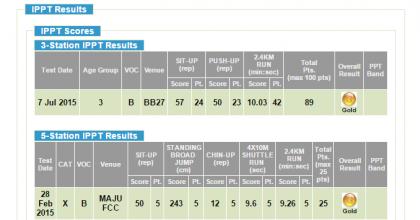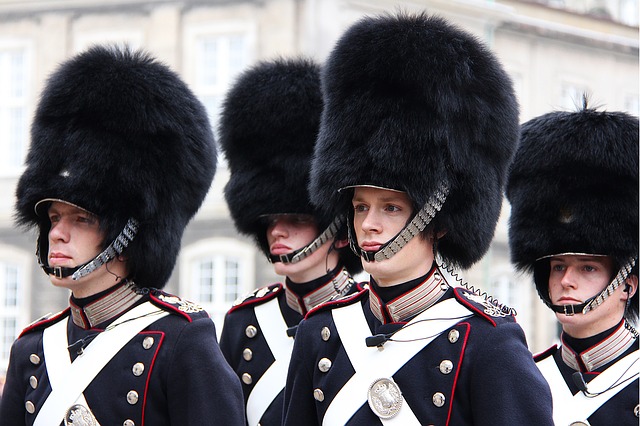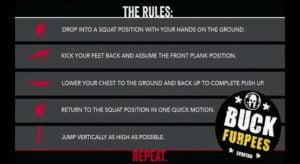Curious about the army fitness tests of other countries? What are the fitness requirements like for foreign soldiers and how do they compare to yours? Explore this list of army fitness tests from 26 countries — inside the continents of Asia, Australia, Africa, Europe, and the Americas.
Check out the overview, which summarises the common requirements, compares the differences, and highlights strange test requirements. Otherwise, use the table of contents to skip to the country you’re most interested in.
Army Fitness Tests Overview: Observations & Comparisons

Soldiers are the modern version of historical ninja and samurai. They have to be fit for physically-demanding tasks and warfare. That is why every army has fitness requirements for both potential recruits and active-duty soldiers.
Where available, I’ve listed army fitness tests that are conducted for active-duty soldiers. Tests for potential recruits are generally lower in standards and would make the comparison unfair. Also, I’ve prioritised fitness tests for the average soldier, instead of tests for special forces and specific units.
The 2 Army Fitness Test Types: Army task-simulations vs Conventional exercises


There seem to be two types of army fitness tests. One evaluates a soldier’s fitness by simulating common tasks performed in the line of active duty. The other assess a soldier through common endurance, aerobic and strength exercises.
Examples of task-simulation include loading a weighted ammo box or carrying Jerry cans over specific distances. Both the Canadian and UK army fitness tests are direct evaluations of a soldier’s physical capability. The US Army’s new test (OPAT) is a hybrid of the two.
An example of endurance, aerobic and strength exercises are push ups, pull ups, crunches and running.
Task simulation tests are less common, as they are a new development.
3 Common Exercises in Most Conventional Fitness Tests (and others)
Many army fitness tests include three standard components:
- push ups
- situps (or crunches)
- run.
These exercises evaluate arm strength, core strength and endurance (or aerobic fitness).
The countries that use these three exercises as test components are USA, Singapore, Philippines, Australia, China, Ireland, Japan, Luxembourg, Italy, Netherlands, New Zealand, Norway, Poland, South Africa, South Korea, Taiwan and Sweden.
There are, of course, more components than these three exercises.
Beep Test and Shuttle Run
Another common component in several countries is the beep test or shuttle run. These are meant to test progressive endurance, reaction time and coordination.
Sense of Balance
Out of all the countries, India and Switzerland test soldiers for their sense of balance. The Swiss balance component is especially intriguing (refer to Switzerland, under the guidelines tab).
Ergometer Gym Bicycle
Finally, several European countries (especially Nordic ones) include Ergometer test as a test component. This test assesses a soldier’s oxygen uptake capacity.
How hard is the army fitness test?

It depends. Most army tests are comparable.
Some countries use a pass-or-fail standard that only requires you to perform a bare minimum number of exercise reps. These are generally easier to pass.
Others divide passes into different grades. Needless to say, getting an excellent grade is tougher.
Even though – for ego’s sake – it’s tempting to compare armies based on their fitness requirements, it paints a really flawed comparison.
For instance, the Italian Army’s recruitment standards are easy to meet. But there is no doubt that once a recruit becomes a soldier, his/her fitness level would rise exponentially.

Lastly, several nations use citizen militias. Because of mandatory service for everyone, passing standards are understandably lower.
Experience with Singapore’s army fitness test
Because I am part of the army reserve, I have to take a fitness test annually. I’ve been awarded Gold for my past two tests and found it easy to pass because I cross-train.
However, the old test system (with 6 test components) was tough even for me. My weakness was in standing broad jumps.
Note: I have yet to take 2016’s test due to my shoulder injury.
Here are the army fitness tests used by 26 nations in the world. Let me know how you think you’d fare.
Want to get army fit?
Level Up With The U.S. Army Fitness Training Handbook!
Whether you’re a soldier aiming for greatness or just want to be warrior fit, this guide has you covered. Get fit, feel good, and live your best life. It’s time to unleash your potential and become a modern ninja.
26 Countries’ Army Fitness Tests & Requirements
#1. Australia – Basic Fitness Assessment


The Australian Defence Force (ADF) uses various fitness assessments to measure its soldiers’ physical fitness. The most relevant one is the Basic Fitness Assessment (BFA). Active personnel take this test every 6 months.
The BFA’s scoring system is simple – you either pass or fail. Passes are NOT divided into grade classes such as Gold, Silver, Bronze.
Test Components – Australia Basic Fitness Assessment (BFA)
- Push ups
- Situps
- 2.4km run (1.5 mile run)
- 5km walk (3.1 miles; only for soldiers older than 40; to be used in lieu of 2.4km run)
Guidelines – Australian Army Physical Fitness Test
The ADF situps are different from regular situps. Their situp method prevents you from using your hip flexors or head as leverage. This eliminates cheating by using any other muscles than your core.
Take a look at the video instructions.
Score Chart – Australia’s Basic Fitness Assessment (BFA)
The pass-or-fail standards differ among age groups and gender. Refer to the table for men and women below.
Male
| Age | Push ups (reps) | Sit ups (reps) | 2.4km / 1.5mile run (min:sec) | 5km / 3.1 mile walk (min:sec) |
|---|---|---|---|---|
| 17 to 25 | 40 | 70 | 11:18 | |
| 26 to 30 | 35 | 65 | 11:48 | |
| 31 to 35 | 30 | 60 | 12:18 | |
| 36 to 40 | 25 | 50 | 12:42 | |
| 41 to 45 | 20 | 35 | 13:12 | 44:00 |
| 46 to 50 | 10 | 25 | 13:48 | 45:00 |
| 51 to 55 | 6 | 20 | 14:30 | 45:00 |
| 56 to 60 | 5 | 15 | 15:30 | 50:00 |
Female
| Age | Push ups (reps) | Sit ups (reps) | 2.4km/1.5mile run (min:sec) | 5km/3.1mile walk (min:sec) |
|---|---|---|---|---|
| 17 to 25 | 21 | 70 | 13:30 | |
| 26 to 30 | 18 | 65 | 14:00 | |
| 31 to 35 | 15 | 60 | 14:30 | |
| 36 to 40 | 10 | 50 | 15:00 | |
| 41 to 45 | 7 | 35 | 15:30 | 45:00 |
| 46 to 50 | 3 | 25 | 16:00 | 47:00 |
| 51 to 55 | 3 | 20 | 16:30 | 47:00 |
| 56 to 60 | 3 | 15 | 17:00 | 52:00 |
Note: 11:18 means 11 minutes 18 seconds
Others – PFA
Here is the Pre-enlistment Fitness Assessment (PFA), different than the BFA. This test is for potential recruits.
For more fitness-related tests of the ADF, refer to this document.
#2. Belgium


The Belgian Army uses a three-component fitness test for potential recruits. I have no further information on annual fitness tests for active-duty soldiers.
Test Components – Belgium Army Fitness Test
- Situps (maximum in 1 minute)
- Push-ups (maximum in 1 minute)
- Treadmill walking test
Test Guidelines – Belgium Army Fitness Test
All the test components are self-explanatory (except the treadmill test).
For the treadmill walking test, start with a 1-minute warm-up walk at 3 to 6 km per hour.
The test begins at 6 km per hour. Speed is increased by 0.3 km per hour every 30 seconds until it reaches 14.4 km/hour. The test lasts no more than 18 minutes and 30 seconds, with the last 3 minutes used for recovery/cool down.
Score Chart – Belgium Army Fitness Test
The push-ups and sit-ups components each account for 10% of the score (20% when combined). The treadmill walking test accounts for 80% of the points.
Push Ups
| Points | Male | Female |
|---|---|---|
| 20 | 25 | 20 |
| 18 | 23 | 18 |
| 16 | 21 | 16 |
| 14 | 19 | 14 |
| 12 | 17 | 12 |
| 10 | 15 | 10 |
| 8 | 12 | 8 |
| 6 | 9 | 6 |
| 4 | 6 | 4 |
| 2 | 3 | 2 |
| 0 | Below 3 | 0 |
Sit Ups
| Points | Male | Female |
|---|---|---|
| 20 | 39 | 29 |
| 18 | 37 | 27 |
| 16 | 36 | 26 |
| 14 | 33 | 24 |
| 12 | 32 | 22 |
| 10 | 30 | 20 |
| 8 | 29 | 18 |
| 6 | 27 | 16 |
| 4 | 25 | 14 |
| 2 | 23 | 11 |
| 0 | Below 23 | Below 11 |
Treadmill Walking Test
| Speed | Point (Male) | Point (Female) |
|---|---|---|
| 14.4 | 20 | 20 |
| 14.1 | 19 | 20 |
| 13.8 | 18 | 20 |
| 13.5 | 17 | 20 |
| 13.2 | 16 | 20 |
| 12.9 | 15 | 20 |
| 12.6 | 14 | 20 |
| 12.3 | 13 | 18 |
| 12.0 | 12 | 16 |
| 11.7 | 11 | 14 |
| 11.4 | 10 | 12 |
| 11.1 | 9 | 9 |
| 10.8 | 8 | 8 |
| 10.5 | 7 | 7 |
| 10.2 | 6 | 6 |
| 9.9 | 5 | 5 |
| 9.6 | 4 | 4 |
| 9.3 | 3 | 3 |
| 9.0 | 2 | 2 |
| 8.7 | 1 | 1 |
| under 8.7 | 0 | 0 |
(retrieved from this document)
#3. Canada – FORCE Evaluation


The Fitness for Operational Requirements of CF Employment (FORCE) assesses the Canadian Forces’ operational fitness. It partly simulates common army duties, and replaces the CF EXPRES Test.
Test Components – FORCE (a.k.a. Canada’s Army Fitness Test)
- Sandbag Lift
- Intermittent Loaded Shuttles
- Sandbag Drag
- 20-metre Rushes
Guidelines – FORCE (a.k.a. Canada’s Army Fitness Test)
| Component | Description |
|---|---|
| Sandbag Lift | Lift 20kg sandbag to the height of one metre for 30 consecutive times within 3 minutes 30 seconds. |
| Intermittent Loaded Shuttles | Shuttle back and forth 10 times for a distance of 20m per shuttle. Alternate between carrying a 20kg sandbag and not carrying anything each shuttle. This needs to be completed within 5 minutes 21 seconds. |
| Sandbag Drag | While carrying a 20kg sandbag, drag at least four sandbags over 20m without stopping within 51 seconds. |
| 20 metre Rushes | Complete 2 shuttle sprints – 20m back and forth, starting from a prone position. Drop into a prone position every 10m. |
More details here.
Score Chart – FORCE (a.k.a. Canada’s Army Fitness Test)
Calculate your FORCE test score with this calculator.
Others – CF EXPRES Test
Before the FORCE Test, the Canadian Forces used the CF EXPRES Test. More information can be found here.
#4. China – 中国人民解放军军人体能标准


The People’s Republic of China assesses its soldiers’ fitness with the People’s Liberation Army’s Soldier Physical Fitness Standards (中国人民解放军军人体能标准). This test applies to conventional soldiers, and not personnel from special units.
According to secondary sources, China updated the standards at the end of 2006. So, the information here may be outdated.
Test Components – 军人体能标 (Soldier’s Physical Standards)
- Push-ups
- Sit-ups
- 10m x 5 back-and-forth sprints
- 3km run (1.86mile)
China’s army fitness test has a height requirement component for soldiers. However, I have omitted that because it is not a test of fitness.
Score Chart – 军人体能标 (a.k.a. China’s Army Fitness Test)
Age Groups Up To 39
| Age | 25 and below | 25 to 29 | 30 to 34 | 34 to 39 | ||||
| Gender | Male | Female | Male | Female | Male | Female | Male | Female |
| Push-ups | 40 | 10 | 36 | 8 | 32 | 7 | 28 | 6 |
| Sit-ups | 45 | 32 | 40 | 30 | 35 | 28 | 30 | 22 |
| 10m x 5 (back and forth) | 27 secs | 32 secs | 28 secs | 33 secs | 29 secs | 35 secs | 31 secs | 38 secs |
| 3km run (min:sec) | 13:40 | 17:00 | 14:30 | 17:30 | 15:00 | 18:00 | 16:00 | 19:00 |
Age Groups 40 To 59
| Age | 40 to 44 | 45 to 49 | 50 to 54 | 55 to 59 | ||||
| Gender | Male | Female | Male | Female | Male | Female | Male | Female |
| Push ups | 20 | 5 | 15 | 4 | 10 | 3 | 5 | 2 |
| Sit ups | 25 | 15 | 20 | 10 | 15 | 6 | 10 | 5 |
| 10m x 5 (back and forth) | 33 secs | 42 secs | 38 secs | 47 secs | 43 secs | 53 secs | 48 secs | 55 secs |
| 3km run (min:sec) | 18:00 | 21:00 | 20:00 | 23:00 | 22:00 | 25:00 | 24:00 | 26:00 |
#5. Denmark – Core Test & Danish Armed Forces Physical Fitness Test


Compared to other Nordic armies, the Royal Danish Army has a greater number of fitness test components. Two tests are used to measure their soldiers’ physical fitness – the Core Test and the Danish Armed Forces Physical Test (DAFPT).
Soldiers in the Army need to complete all test components in the DAFPT; Air Force and Navy soldiers are exempt from Block D tests of the DAFPT (refer to the score tab to gain an understanding).
Scores are categorized into various grades.
Test Components of 2 Danish Army Fitness Tests – The Core Test & DAFPT
Core Test
- Back
- 90° Static Sit-up
- Side bridge Left/Right
- Backbridge Left/Right
- Lunges
Danish Armed Forces Physical Test
- 12-Minute Run (Distance run in 12 minutes)
- Yo-Yo UH 1 (20m Shuttle-Run)
- YO-YO IR 1 (20m Shuttle-Run with Pauses)
- The Danish Military Speed Test
- Lunges (maximum in 2 minutes)
- Dips (maximum in 1 minute)
- Pull-Ups (maximum in 1 minute)
- Dead-lifts (maximum in 1 minute)
- The Plank
Please refer to pages 26 to 31 of Physical Fitness Tests in the Nordic Armed Forces (01/2011) to learn how to perform the exercises in both tests.
Core Test Score
Grade 3 and above are acceptable.
| Test Components/Grade | 5 | 4 | 3 | 2 | 1 |
|---|---|---|---|---|---|
| Back | 165 sec. | 150 sec. | 135 sec. | 120 sec. | 105 sec. |
| 90°Static Sit-up | 135 sec. | 120 sec. | 105 sec. | 90 sec. | 75 sec. |
| Side bridge Left/Right | 120 sec. | 105 sec. | 90 sec. | 75 sec. | 60 sec. |
| Backbridge Left/Right | 90 sec. | 75 sec. | 60 sec. | 45 sec. | 30 sec. |
| Lunges (20kg) | 60 reps. | 50 reps. | 40 reps. | 30 reps. | 20 reps. |
(Data retrieved from this document)
Danish Armed Forces Physical Test (Grade 5 To 3)
| Block Category | Test Components | 5 | 4 | 3 |
|---|---|---|---|---|
| Block A | 12-Minute Run (Distance run in 12 minutes) | 3000m | 2850m | 2750m |
| Yo-Yo UH 1 (20m Shuttle-Run) | 14.6sec | 13.2sec | 12.8sec | |
| Block B | YO-YO IR 1 (20m Shuttle-Run with Pauses) | 19.4sec | 18.3sec | 17.5sec |
| Danish Military Speed Test | 66 rounds | 63 rounds | 60 rounds | |
| Block C | Lunges (maximum in 2 min) | 40 rep 50kg | 40 rep 40kg | 30rep 40kg |
| Dips (maximum in 1 min) | 8rep 10kg | 8rep 0kg | 6rep 0kg | |
| Pull-Ups (maximum in 1 min) | 8rep 10kg | 8rep 0kg | 6rep 0kg | |
| Dead-lifts (maximum in 1 min) | 8rep 100kg | 8rep 80kg | 6rep 80kg | |
| The Plank | 120sec 20kg | 120sec 15kg | 120sec 10kg | |
| Block D | Information omitted – these are obstacle course and marching related tests | |||
Danish Armed Forces Physical Test (Grade 2 To 0)
| Block Category | Test Components | 2 | 1 | 0 |
|---|---|---|---|---|
| Block A | 12 Minute Run (Distance run in 12 minutes) | 2550m | 2400m | 2150m |
| Yo-Yo UH 1 (20m Shuttle-Run) | 11.2sec | 9.11sec | 8.8sec | |
| Block B | YO-YO IR 1 (20m Shuttle-Run with Pauses) | 15.6sec | 14.6sec | 11.2sec |
| The Danish Military Speed Test | 58 rounds | 54 rounds | 49 rounds | |
| Block C | Lunges (maximum in 2 min) | 30rep 30kg | 30rep 10kg | 20rep 10kg |
| Dips (maximum in 1 min) | 4rep 0kg | 2rep 0kg | 1rep 0kg | |
| Pull-Ups (maximum in 1 min) | 4rep 0kg | 2rep 0kg | 1rep 0kg | |
| Dead-lifts (maximum in 1 min) | 6rep 60kg | 6rep 50kg | 6rep 40kg | |
| The Plank | 120sec 0kg | 90sec 0kg | Information omitted – these are obstacle course and marching-related tests | |
| Block D | Information omitted – these are obstacle course and marching related tests | |||
(Data retrieved from this document)
#6. Finland – Fitness Test


The Finnish Defence Forces (FDF) holds a compulsory annual fitness test for all its professional soldiers. The scores are graded based on the soldier’s level of fitness.
Test Components – Finland’s Army Fitness Test
Core Test
- 12-minute Run (Bicycle Ergometer Test or The UKK Walk Test for over 45 years old)
- Sit-ups (maximum in 1 minute)
- Push-ups (maximum in 1 minute)
- Standing Long Jump
- BMI/Waist circumference
Even though the BMI/Waist circumference is not an exercise, it is a measure of body fat (related to fitness). That’s why I’ve included it.
All exercises are self-explanatory except the following:
| Component | Description |
|---|---|
| 12 Minute Run | Measures maximum distance covered in a 12 minute time frame. |
| Bicycle Ergometer Test & UKK Walk | Two separate tests for maximal oxygen uptake (better explanation on page 39 and 41. |
Refer to Appendix 1 on page 73 of Physical Fitness Tests in the Nordic Armed Forces (01/2011). The scoring matrix is far too long to include in this section.
#7. Germany – Basis Fitness Test


The German Army (Deutsches Heer) holds the Basis (Basic) Fitness Test to assess the physical fitness of its soldiers. This test uses a scoring matrix to distinguish quality of passes.
Test Components – Basis Fitness Test (German Army Fitness Test)
- 11 × 10-m sprint test
- Pull up hang
- 1km (0.62mile) run or 3km (1.86mile) on gym bike
Guidelines – Basis Fitness Test (German Army Fitness Test)
The running and bicycling components are self-explanatory.
| Component | Description |
|---|---|
| 11 × 10-m sprint test | First of all, start from a prone position at the starting line and run 10 metres to the end. Run back and return to prone position with the hands at the back. Repeat this 11 times. |
| Pull up hang | Pull up so that your chin is above the bar and hold it there for the maximum duration you can. |
For illustrations refer to page 17 of Ausbildung und Erhalt der individuellen Grundfertigkeiten und der Körperlichen Leistungsfähigkeit.
Score Chart – Basis Fitness Test (German Army Fitness Test)
The following table merely displays the passing standards. Find out your actual score using the scoring matrix only if you meet the passing standards below.
| Component | Passing Requirement |
|---|---|
| 11 × 10-m sprint test | complete in 60 seconds |
| Pull up hang (chin above bar) | at least 5 seconds |
| 1km run or 3km on gym bike | maximum 6 minutes 30 seconds (for either) |
For the full score matrix refer to Ausbildung und Erhalt der individuellen Grundfertigkeiten und der Körperlichen Leistungsfähigkeit (refer to page 27 to 29, section 5.4.9 Basispunktetabelle zum BFT).
Assuming you can’t read in German, here are some key terms:
- 11 × 10 m-Sprinttest refers to the 11 × 10 m Sprint test.
- Klimmhang refers to the pull up hang
- 1000-m-Lauf refers to the 1km run
- Zeit (Sek.) means Time (Sec.); Punkte means Points.
#8. India – Physical Fitness Test (PFT)


The Indian Army’s Physical Fitness Test (PFT) assess potential recruits’ fitness standards. However, I can’t find further information for active personnel.
The PFT distinguishes recruits’s fitness standards into two groups – Group 1 being better than Group 2.
Test Components – India’s Physical Fitness Test (PFT)
- 1.6km run (1 mile)
- Pull-ups
- Balance (walking on a balancing beam)
- 9-feet ditch (jumping across the ditch)
Guidelines – Indian Army’s Physical Fitness Test (PFT)
The video above shows how the Indian Army fitness test is conducted.
Score Chart – Indian Army’s Physical Fitness Test (PFT)
The scoring system distinguishes passing marks into groups 1 and 2. The first group is superior in fitness to the second.
| Test | Soldiers (others) | Soldiers (general duty) |
|---|---|---|
| 1.6 km run | Group 1: 05:40 and below – 60 marksGroup 2: 05:41 to 6:20 – 48 marksFail: 06:21 and above | Group 1: 05:40 and below – 60 marksGroup 2: 05:41 to 6:00 – 48 marksFail: 06:00 and above |
| Pull ups | 10 and above pull ups: 40 marks9 pull ups: 33 marks8 pull ups: 27 marks7 pull ups: 21 marks6 pull ups: 16 marks | 10 and above pull ups: 40 marks9 pull ups: 33 marks8 pull ups: 27 marks7 pull ups: 21 marks6 pull ups: 16 marks |
| Balance | Either pass or fail (need to pass) | Either pass or fail (need to pass) |
| 9 feet ditch | Either pass or fail (need to pass) | Either pass or fail (need to pass) |
Note: Additional 1.6km run time provisions for various terrains exist. Refer to this for additional information. (05:40 refers to 05 mins 40 seconds)
#9. Republic of Ireland – Fitness Test


What is the Irish Army fitness test?
The Irish Defense Forces (of the Republic of Ireland) uses a pass-or-fail-only standard, with no scores to distinguish passes. Only the running standards differ between male and female soldiers.
Test Components – Irish Defense Forces Fitness Test
- Push-ups* (within 1 minute)
- Sit-ups (within 1 minute)
- 2.4km run (1.5mile)
*Female soldiers are allowed to do modified push ups.
Score Chart – Irish Defense Forces Fitness Test
Score
| Push ups (max in 1 min) | Sit ups (max in 1 min) | 2.4km run (1.5 mile) | |
|---|---|---|---|
| Male | 20 | 20 | 11.40 |
| Female | 20 | 20 | 13.10 |
#10. Israel – בוחן בר-אור


The Israel Defense Forces (IDF) uses the Bar Or Test (בוחן בר-אור) to assess the fitness of its soldiers. The test was designed by Professor Oded Bar Or, which explains the test’s name.
Test Components – בוחן בר-אור (Bar-Or Test)
- Pull-ups (max – no time limit)
- Dips (max – no time limit)
- 3km run (1.86mile)
Score Chart – Bar-Or (a.k.a. Israel Army Fitness Test)
Pull up & Dips
The pull-up and dips component uses a pass-or-fail requirement. Not meeting the below requirements results in immediate failure of the Bar Or Test.
- Pull-ups: At least 11
- Dips: At least 18
3km Run
The 3km run is scored according to this table.
| Points | Timing | Points | Timing | Points | Timing | Points | Timing |
| 100 | 10:12 | 87 | 11:30-11:36 | 74 | 12:54-12:59 | 61 | 14:17-14:22 |
| 99 | 10:13-10:19 | 86 | 11:37-11:42 | 73 | 13:00-13:05 | 60 | 14:23-14:29 |
| 98 | 10:20-10:25 | 85 | 11:43-11:48 | 72 | 13:06-13:12 | 59 | 14:30-14:35 |
| 97 | 10:26-10:31 | 84 | 11:49-11:55 | 71 | 13:13-13:18 | 58 | 14:36-14:42 |
| 96 | 10:32-10:38 | 83 | 11:56-12:01 | 70 | 13:19-13:25 | 57 | 14:43-14:48 |
| 95 | 10:39-10:44 | 82 | 12:02-12:08 | 69 | 13:26-13:31 | 56 | 14:49-14:54 |
| 94 | 10:45-10:51 | 81 | 12:09-12:14 | 68 | 13:32-13:37 | 55 | 14:55-15:01 |
| 93 | 10:52-10:57 | 80 | 12:15-12:20 | 67 | 13:38-13:44 | 54 | 15:02-15:07 |
| 92 | 10:58-11:03 | 79 | 12:21-12:27 | 66 | 13:45-13:50 | 53 | 15:08-15:14 |
| 91 | 11:04-11:10 | 78 | 12:28-12:33 | 65 | 13:51-13:57 | 52 | 15:15-15:20 |
| 90 | 11:11-11:16 | 77 | 12:34-12:40 | 64 | 13:58-14:03 | 51 | 15:21-15:26 |
| 89 | 11:17-11:23 | 76 | 12:41-12:46 | 63 | 14:04-14:10 | 50 | 15:27-15:33 |
| 88 | 11:24-11:29 | 75 | 12:47-12:53 | 62 | 14:11-14:16 | Fail | 15:34 |
#11. Japan – 自衛隊体力検定


The Japan Self-Defense Forces (JSDF) uses the following fitness test (自衛隊体力検定) to measure their soldiers’ fitness standards. Source data was last updated in 2007.
Test Components – 自衛隊体力検定 (A.k.a. Japan’s Army Fitness Test)
According to Physical Fitness Measurement Practice Standards of Aviation Self-Defense Forces (Notice), the fitness test is separated into two measurement sets.
Physical Fitness Measurement 1
- Push-ups (maximum in 2 mins)
- Sit-ups (maximum in 2 mins)
- 3km run (1.86mile)
Physical Fitness Measurement 2
- Running long jump
- Pull-ups (inclined pull-ups for female soldiers)
- Softball toss (180g ball)
Score Chart – 自衛隊体力検定 (A.k.a. Japan’s Army Fitness Test)
If you are interested in the scoring matrix, please subscribe to the email list at the end of the article. I’m working on translating the entire matrix.
Physical Fitness Measurement 1 (Award)
| Grade | Points |
|---|---|
| 1 | 94 |
| 2 | 86 |
| 3 | 78 |
| 4 | 73 |
| 5 | 68 |
| 6 | 60 |
| 7 | 45 |
Physical Fitness Measurement 2 (Award)
| Grade | Points |
|---|---|
| 1 | 70 |
| 2 | 60 |
| 3 | 50 |
| 4 | 40 |
| 5 | 30 |
| 6 | 20 |
Sample scores for male soldier below the age of 25
| Grade 1 | Other Grade Classes | Lowest Grade in Score Matrix | |
| Pushups | 82 and above | In process of translation | 21 |
| Sit ups | 80 and above | 30 | |
| 3km run | 10.38 and above | 16:20 | |
| Running long jump | 5m 10 cm | 360cm | |
| Pull up | 17 and above | 3 | |
| Softball toss | 60m and above | 30m |
(Data compiled from 新体力テスト・体力検定対比表 and 航空自衛官の体力測定実施基準について通達))
#12. Italy


Since the Italian Army’s (Esercito Italiano’s) annual fitness test details cannot be found, the recruitment fitness assessment is included instead. This is a straightforward pass-or-fail test.
Test Components – Recruitment Fitness Test
What does the Italian army fitness test involve?
- Push-ups (maximum in 2 minutes)
- Crunches (maximum in 2 minutes)
- 1km run (0.62mile)
Score Chart
The Italian Army uses a pass-fail standard with no graded distinctions in passes.
| Male | Female | |
|---|---|---|
| Push ups | 8 | 6 |
| Crunches | 10 | 8 |
| 1km run | 5.45 | 6.15 |
(data retrieved from the Italian Ministry of Defense document)
#13. Luxembourg


The physical fitness test of the Luxembourg Army has six components and is assumed to be a recruitment standard.
Test Components – Luxembourg Army Recruitment Fitness Test
- Seated 3kg ball throw
- Sit-ups
- Standing long jump
- 24 metres course
- Push-ups
- 2.4km run (1.5mile)
Guidelines – Luxembourg Army Recruitment Fitness Test
Every component is self-explanatory, except for the following.
Seated 3kg ball throw
Assumed to be similar to the Swiss Army ball throw.
24 metres course
24 metres course require the soldier to lie behind the starting line in a prone position, head facing the finishing line. Then get up and sprint to the end.
Score Chart – Luxembourg Army Recruitment Fitness Test
| Points | 20 points | 10 points | 1 point | |
|---|---|---|---|---|
| 3kg Ball Throw | Male | 7.10m or more | 5.20m or more | 3.50m or more |
| Female | 6.20m or more | 4.90m or more | 2.80m or more | |
| Sit ups (2min) | Male | 74 or more | 45 or more | 20 or more |
| Female | 68 or more | 39 or more | 18 or more | |
| Standing long jump | Male | 2.50m or more | 2.00m or more | 1.55m or more |
| Female | 2.40m or more | 1.90m or more | 1.45m or more | |
| 24 metres course | Male | 4.2 sec or more | 5.2 sec or more | 5.8 sec or more |
| Female | 4.4 sec or more | 5.4 sec or more | 6.0 sec or more | |
| Push ups (2mins) | Male | 64 or more | 36 or more | 18 or more |
| Female | 39 or more | 24 or more | 10 or more | |
| 2.4km run (min:sec) | Male | 09:45 or faster | 12:15 or faster | 14:30 or faster |
| Female | 11:05 or faster | 13:35 or faster | 15:50 or faster |
#14. Netherlands


The Royal Netherlands Army conducts a mandatory fitness test – Defensie Conditie Proef (DCP). This is an annual fitness test that was first implemented in 2009.
Test Components – Defensie Conditie Proef (A.K.A. Netherlands Army Fitness test)
- Push-ups
- Sit-ups
- 12-minute run test
Score Chart – Passing Standards of Defensie Conditie Proef (A.K.A. Netherlands Army Fitness test)
Push up score
| Age group | Male | Female |
|---|---|---|
| 30 and under | 20 | 10 |
| 31 to 35 | 18 | 8 |
| 36 to 40 | 16 | 6 |
| 41 to 45 | 14 | 5 |
| 46 to 50 | 12 | 4 |
| 51 to 55 | 10 | 3 |
| 56 to 60 | 8 | 2 |
| 61 and older | 6 | 1 |
Sit up score
| Age group | Male | Female |
|---|---|---|
| 30 and under | 30 | 20 |
| 31 to 35 | 27 | 17 |
| 36 to 40 | 24 | 14 |
| 41 to 45 | 21 | 11 |
| 46 to 50 | 18 | 8 |
| 51 to 55 | 15 | 5 |
| 56 to 60 | 12 | 22 |
| 61 and older | 9 | 0 |
12-minute run test
| Age group | Male | Female |
|---|---|---|
| 30 and under | 2400m | 1900m |
| 31 to 35 | 2300m | 1800m |
| 36 to 40 | 2200m | 1700m |
| 41 to 45 | 2100m | 1600m |
| 46 to 50 | 2000m | 1500m |
| 51 to 55 | 1900m | 1400m |
| 56 to 60 | 1800m | 1300m |
| 61 and older | 1700m | 1200m |
#15. New Zealand – Ongoing Fitness Requirement


The New Zealand Army (NZ Army) has several fitness testing requirements. The one most relevant to this list is the Ongoing Fitness Requirement (OFR), since its a semi-annual army fitness test.
Test Components – Ongoing Fitness Requirement (New Zealand’s Army Fitness Test)
- 2.4km run (1.5 miles)
- Curl-ups
- Press-ups (aka. push-ups)
Score Chart – Ongoing Fitness Requirement (New Zealand’s Army Fitness Test)
The score tables below only include test standards for soldiers aged 25 years-old and below. While the NZ Army fitness test makes allowances for soldiers older than that, this information is not available.
Passing scores are distinguished into: the 100 Club, Grade 1 and Grade 2 (in the order of descending fitness standard).
| 2.4km run | Curl ups | Press ups | |
|---|---|---|---|
| Male | Required Fitness Level: 100 Club: 08.00 Grade 1: 10.00 Grade 2: 10.30 | Required Fitness Level: 100 Club: 130 Grade 1: 66 Grade 2: 60 | Required Fitness Level: 100 Club: 55 Grade 1: 30 Grade 2: 28 |
| Female | Required Fitness Level: 100 Club: 10.05 Grade 1: 11.50 Grade 2: 12.20 | Required Fitness Level: 100 Club: 118 Grade 1: 55 Grade 2: 50 | Required Fitness Level: 100 Club: 36 Grade 1: 15 Grade 2: 14 |
#16. Norway


The Norwegian Armed Forces grade its physical fitness standards on a scale of 0 to 6. The current test is slated to be replaced in January 2017. Refer to the tab: Others – New Test 2017.
Test Components – Norway’s Army Fitness Test
- 3km run (1.86mile)
- Pull-ups (inclined pull-ups for women)
- Sit-ups
- Push-ups
Guidelines – Norway’s Army Fitness Test
Please refer to pages 49 to 50 of Physical Fitness Tests in the Nordic Armed Forces (01/2011) to learn how to perform the components.
Score Chart – Norway’s Army Fitness Test
Test scores are classified on a scale of 0 to 6 (6 being the best and 2 being the passing grade).
Male
| Exercise/Grade | 6 | 5 | 4 | 3 | 2 | 1 | 0 |
|---|---|---|---|---|---|---|---|
| 3km run | 11:00 | 12:00 | 13:00 | 14:00 | 15:00 | 16:00 | above 16:00 |
| Pull ups | 14 | 12 | 9 | 6 | 4 | 2 | below 2 |
| Sit-ups | 70 | 58 | 46 | 34 | 20 | 10 | below 10 |
| Push-ups | 45 | 39 | 32 | 24 | 16 | 9 | below 9 |
Female
| Exercise/Grade | 6 | 5 | 4 | 3 | 2 | 1 | 0 |
|---|---|---|---|---|---|---|---|
| 3km run | 12:00 | 13:00 | 14:30 | 15:30 | 16:30 | 17:30 | above 17:30 |
| Inclined pull-ups | 20 | 16 | 12 | 8 | 5 | 3 | below 3 |
| Sit-ups | 70 | 58 | 46 | 34 | 20 | 10 | below 10 |
| Push-ups | 26 | 22 | 18 | 14 | 10 | 6 | below 6 |
What does the new army fitness test involve?
- 3km run (where conditions are bad to conduct the 3km, the Bip test will be given)
- Strength tests (10kg medicine ball throw, standing long jump and pull-ups)
- 200m swim (No time requirement)
Calculation of scores and video guidelines available here. Test will only be rolled out on 1 January 2017.
#17. Philipines – Army Physical Fitness Test


The Army Physical Fitness Test components and standards for the Philippines Army may not be accurate. I have inferred it based on the year 2008 standards and other updated news sources.
The old test is included in the Others – Old Test tab below.
Test Components – Philipines Army Physical Fitness Test
- Push-ups (max in 2 mins)
- Sit-ups (max in 2 mins)
- 2km run* (1.24mile)
According to PhilStar, the 3.2km run has been replaced with a 2km run component.
Score Chart – Philipines Army Physical Fitness Test
The full scoring system is assumed to be same the as the old test (refer to the Others – Old Test tab), except for the run. The 2km run test requirement was retrieved from PhilStar’s report.
2km Test Requirement
- Male (under 21 years old): 12.30
- Female (under 21 years old): 14.00
The time requirement is adjusted for older soldiers.
- Male (aged 52 to 56): 21.10
- Female (aged 52 to 56): 22.50
Others – Old Test
The standards for the old test are for soldier recruits (aged 17 to 22 years-old).
| Male | Female | |
|---|---|---|
| Push ups (max in 2 mins) | 35 | 25 |
| Sit ups (max in 2 mins) | 30 | 25 |
| 3.2km run (2 miles) | 19.00 | 21.00 |
This is based on the Philippines Military Academy requirements for recruits (dated 2010) and Bald Runner’s blog recounting his APFT Challenge in 2008. Standards for those above 22 years of age are unknown.
#18. Poland


The Polish Land Forces (Wojska Lądowe) uses the following test to evaluate the fitness standard of its soldiers.
Test Components – Polish Army Fitness Test
- 3km (1.86mile – male)/1km (0.62mile – female)
- Pull ups (male)/Inclined pull ups (female)
- Sit ups
- 10 x 10m shuttle run (male)/zig-zag run (female)
Guidelines – Polish Army Fitness Test
All components are self-explanatory except the 10 x 10 shuttle run and zig-zag run.
10 x 10m shuttle run
Begin at the beep. Run towards the flag at the end (10m away) and circle back to the starting line. Repeat this five times.
Zig-zag Run
Complicated to prepare and replicate.
Score Chart – Polish Army Fitness Test
Since there are separate scores for different groups, I have added the lowest standard for soldiers below. Special unit grades were omitted and can be found here (original language: Polish).
The score is calculated by getting the arithmetic mean (average) of the individual component’s grade.
- 4.51 or more – very good
- 3.51 to 4.50 – good
- 2.51 to 3.50 – good
- 2.50 and lower – fail
Male
| Age 25 and under | Age 26 to 30 | Ages above 30 | ||||||||
| Exercises | Unit of measure/Grade | 5 | 4 | 3 | 5 | 4 | 3 | 5 | 4 | 3 |
| 3km run | min.sec | 13.50 | 14.50 | 16.10 | 14.15 | 15.15 | 16.35 | 14.40 | 15.40 | 17.00 |
| Pull ups | reps | 10 | 8 | 6 | 9 | 7 | 5 | 8 | 5 | 3 |
| Sit ups (max in 2mins) | reps | 50 | 40 | 35 | 45 | 35 | 30 | 40 | 30 | 25 |
| 10 x 10m shuttle run | sec. | 31.0 | 32.0 | 33.2 | 31.4 | 32.4 | 33.6 | 31.8 | 32.8 | 34.0 |
Female
| Age 25 and under | Age 26 to 30 | Ages above 30 | ||||||||
| Exercises | Unit of measure/Grade | 5 | 4 | 3 | 5 | 4 | 3 | 5 | 4 | 3 |
| 1km run | min.sec | 4.45 | 5.10 | 5.50 | 5.00 | 5.20 | 6.05 | 5.15 | 5.35 | 6.20 |
| Inclined pull ups | reps | 28 | 23 | 18 | 25 | 20 | 15 | 22 | 17 | 12 |
| Sit ups (max in 2mins) | reps | 37 | 32 | 28 | 35 | 30 | 26 | 33 | 28 | 24 |
| Running zig-zag | sec. | 27.0 | 28.0 | 29.5 | 27.5 | 28.5 | 30.0 | 28.0 | 30.0 | 30.5 |
#19. Singapore – Individual Physical Proficiency Test (IPPT)


All active and reservist soldiers of the Singapore Armed Forces (SAF) are required to take an annual fitness test known as the IPPT (Individual Physical Proficiency Test). The Singapore Police Force and Singapore Civil Defence also use the same test.
Your total score of all components would determine the class of award you qualify for: Gold, Silver or pass. If you fail, you have to attend remedial training.
Test Components – IPPT (a.k.a Singapore’s Army Fitness Test)
- Push-ups (Maximum repetitions in 60 secs)
- Sit-ups (Maximum repetitions in 60 secs)
- 2.4km run (1.5 mile)
Guidelines – IPPT (a.k.a Singapore’s Army Fitness Test)
All test components are self-explanatory. Female soldiers are allowed to do modified push-ups.
Score Chart – IPPT (a.k.a Singapore’s Army Fitness Test)
The scoring matrix accounts for gender and 14 different age groups. It is too long to include here.
Use this IPPT calculator to get your score instead. Or, if you are crazy, find the different scoring details here.
Award Table
| Award | Score |
|---|---|
| Gold (Commandos & Guards)* | 90 and above |
| Gold (regular personnel) | 85 and above |
| Silver | 75 and above |
| Pass | 51 and above |
Those in the Commandos, Guards and Naval Divers unit are held to a higher standard for the Gold award.*
#20. South Africa


The South African Defence Force’s fitness test was retrieved from a University presentation and cross-referenced against a 2012 scholarly journal. However, the information is incomplete and may be outdated.
Test Components – SADF military fitness test
- 2.4km run (1.5mile run)
- 2 min push ups
- 2 min sit-ups
- 10x25m shuttle run
- 4km walk (2.485mile)
(based on 2012 scholarly journal)
Score
Although the scoring system is not known, use the SADF Special Forces Entry Test as an approximation.
Others – Special Forces Entry Test
- 40 push-ups without breaking rhythm
- 67 sit-ups within two minutes
- 175-metre fireman’s-lift run within 65 seconds
- 5-kilometre run within 24 minutes
- 40 six-metre shuttle-runs within 95 seconds
(Based on this report)
#21. South Korea


Similar to Singapore and Taiwan, all men in South Korea undergo mandatory military service with the Republic of Korea Army (ROKA/대한민국 육군/大韓民國 陸軍).
In addition, they have to take an annual fitness test (aka 체력검정 or 體力檢定), which is similar to the US Army APFT.
Test Components – 체력검정 (a.k.a. South Korean Army Fitness Test)
- Sit-ups (max in 2 mins)
- Push-ups (max in 2 mins)
- 3km run (1.86miles)
Score Chart – 체력검정 (a.k.a. South Korean Army Fitness Test)
These are the translated scoring matrix, broken down by age group and gender.
Male (ages up to 46)
| Event | Rating | Age | ||||||
| 25 and below | 26 to 30 | 31 to 35 | 36 to 40 | 41 to 43 | 44 to 46 | |||
| Push ups (2 mins) | Pass | Express | 72 or more | 70 or more | 68 or more | 65 or more | 61 or more | 57 or more |
| Grade 1 | 64 – 71 | 62-69 | 60-67 | 57-64 | 53-60 | 49-56 | ||
| Grade 2 | 56-63 | 54-61 | 52-59 | 49-56 | 45-52 | 41-48 | ||
| Grade 3 | 48-55 | 46-53 | 44-51 | 41-48 | 37-44 | 33-40 | ||
| Fail | Doesn’t meet the minimum of Grade 3 | |||||||
| Sit ups (2 mins) | Pass | Express | 82 or more | 80 or more | 76 or more | 72 or more | 68 or more | 64 or more |
| Grade 1 | 74-81 | 72-79 | 68-75 | 64-71 | 60-67 | 56-63 | ||
| Grade 2 | 66-73 | 64-71 | 61-67 | 56-63 | 52-59 | 48-55 | ||
| Grade 3 | 58-65 | 56-63 | 53-60 | 48-55 | 44-51 | 40-47 | ||
| Fail | Doesn’t meet the minimum of Grade 3 | |||||||
| 3KM Run | Pass | Express | 12:30 and below | 12:45 and below | 13:00 and below | 13:15 and below | 13:30 and below | 13:45 and below |
| Grade 1 | 12:31-13:32 | 12:46-13:52 | 13:01-14:12 | 13:16-14:32 | 13:31-14:4 | 13:46-15:05 | ||
| Grade 2 | 13:33-14:34 | 13:53-14:59 | 14:13-15:24 | 14:33-15:49 | 14:50-16:07 | 15:06-16:26 | ||
| Grade 3 | 14:35-15:36 | 15:00-16:06 | 15:25-16:36 | 15:50-17:06 | 16:08-17:26 | 16:27-17:46 | ||
| Fail | Doesn’t meet the minimum of Grade 3 | |||||||
Male (ages 47 and above)
| Event | Rating | Age | ||||
| 47 to 49 | 50 to 51 | 52 to 53 | 54 and above | |||
| Push ups (2 mins) | Pass | Express | 54 or more | 51 or more | 49 or more | 47 or more |
| Grade 1 | 46-53 | 43-50 | 41-48 | 39-46 | ||
| Grade 2 | 38-45 | 35-42 | 33-40 | 31-38 | ||
| Grade 3 | 30-37 | 27-34 | 25-32 | 23-30 | ||
| Fail | Doesn’t meet the minimum of Grade 3 | |||||
| Sit ups (2 mins) | Pass | Express | 61 or more | 58 or more | 56 or more | 54 or more |
| Grade 1 | 53-60 | 50-57 | 48-55 | 46-53 | ||
| Grade 2 | 45-52 | 42-49 | 40-47 | 38-45 | ||
| Grade 3 | 37-44 | 34-41 | 32-39 | 30-37 | ||
| Fail | Doesn’t meet the minimum of Grade 3 | |||||
| 3KM Run | Pass | Express | 14:00 and below | 14:15 and below | 14:30 and below | 14:45 and below |
| Grade 1 | 14:01-15:25 | 14:16-15:42 | 14:31-16:02 | 14:46-16:19 | ||
| Grade 2 | 15:26-16:51 | 15:43-17:09 | 16:03-17:34 | 16:20-17:52 | ||
| Grade 3 | 16:52-18:16 | 17:10-18:36 | 17:35-19:06 | 17:53-19:26 | ||
| Fail | Doesn’t meet the minimum of Grade 3 | |||||
Female (ages up to 46)
| Event | Rating | Age | ||||||
| 25 and below | 26 to 30 | 31 to 35 | 36 to 40 | 41 to 43 | 44 to 46 | |||
| Push ups (2 mins) | Pass | Express | 35 or more | 33 or more | 31 or more | 29 or more | 26 or more | 24 or more |
| Grade 1 | 31-34 | 29-32 | 27-30 | 25-28 | 23-25 | 21-23 | ||
| 27-30 | 26-28 | 23-26 | 22-24 | 19-22 | 18-20 | |||
| Grade 3 | 23-26 | 22-25 | 20-22 | 18-21 | 16-18 | 15-17 | ||
| Fail | Doesn’t meet the minimum of Grade 3 | |||||||
| Sit ups (2 mins) | Pass | Express | 67 or more | 64 or more | 62 or more | 59 or more | 56 or more | 53 or more |
| Grade 1 | 59-66 | 56-63 | 54-61 | 51-58 | 48-55 | 45-52 | ||
| Grade 2 | 51-58 | 48-55 | 46-53 | 43-50 | 40-47 | 37-44 | ||
| Grade 3 | 43-50 | 41-47 | 38-45 | 35-42 | 32-39 | 29-36 | ||
| Fail | Doesn’t meet the minimum of Grade 3 | |||||||
| 3KM Run | Pass | Express | 15:00 and below | 15:18 and below | 15:36 and below | 15:54 and below | 16:12 and below | 16:30 and below |
| Grade 1 | 15:01-16:14 | 15:19-16:38 | 15:37-17:02 | 15:55-17:26 | 16:13-17:46 | 16:31-18:06 | ||
| Grade 2 | 16:15-17:29 | 16:39-17:59 | 17:03-18:29 | 17:27-18:59 | 17:47-19:21 | 18:07-19:43 | ||
| Grade 3 | 17:30-18:43 | 18:00-19:19 | 18:30-19:55 | 19:00-20:31 | 19:22-20:55 | 19:44-21:19 | ||
| Fail | Doesn’t meet the minimum of Grade 3 | |||||||
Female (ages 47 and above)
| Event | Rating | Age | ||||
| 47 to 49 | 50 to 51 | 52 to 53 | 54 and above | |||
| Push ups (2 mins) | Pass | Express | 22 or more | 19 or more | 17 or more | 15 or more |
| Grade 1 | 19-21 | 17-18 | 14-16 | 13-14 | ||
| Grade 2 | 16-18 | 14-16 | 12-13 | 10-12 | ||
| Grade 3 | 13-15 | 11-13 | 9-11 | 8-9 | ||
| Fail | Doesn’t meet the minimum of Grade 3 | |||||
| Sit ups (2 mins) | Pass | Express | 51 or more | 50 or more | 49 or more | 48 or more |
| Grade 1 | 43-50 | 42-49 | 41-48 | 40-47 | ||
| Grade 2 | 35-42 | 34-41 | 33-40 | 32-39 | ||
| Grade 3 | 27-34 | 26-33 | 25-32 | 24-31 | ||
| Fail | Doesn’t meet the minimum of Grade 3 | |||||
| 3KM Run | Pass | Express | 16:48 and below | 17:06 and below | 17:24 and below | 17:42 and below |
| Grade 1 | 16:49-18:30 | 17:07-18:50 | 17:25-19:14 | 17:43-19:34 | ||
| Grade 2 | 18:31-20:13 | 18:51-20:35 | 19:15-21:05 | 19:35-21:27 | ||
| Grade 3 | 20:14-21:55 | 20:36-22:19 | 21:06-22:55 | 21:28-23:19 | ||
| Fail | Doesn’t meet the minimum of Grade 3 | |||||
For greater accurcy, the score was cross-referenced and translated from Korean to English from two sources: Kyungdong University Reserve Officers Training Corps & blog post on Captain Park (site managed by the Ministry of National Defense).
#22. Sweden


The Swedish Armed Forces (FM) holds all its soldiers to the standards of the following fitness test, which includes running while carrying fighting equipment.
Test Components – Swedish Armed Forces Fitness Test
- Field test 2km (running in fighting equipment)
- Multitest Strength
- Push-ups
- Sit-ups
- Vertical Jump
- Back Suspension
- Arm Suspension
Guidelines – Swedish Armed Forces Fitness Test
Please refer to pages 61 to 65 of Physical Fitness Tests in the Nordic Armed Forces (01/2011) to learn how to perform the components.
Score Chart – Swedish Armed Forces Fitness Test
| Components | Unit | Min | Max | Points = excess over Min Level |
|---|---|---|---|---|
| Push ups | rep | 8 | 28 | 5 points per rep |
| Sit ups | rep | 10 | 60 | 2 points per rep |
| Vertical Jump | cm | 30 | 50 | 5 points per cm |
| Back Suspension | sec. | 60 | 160 | 1 point per sec. |
| Arm Suspension | sec. | 15 | 65 | 2 points per sec. |
Example: If you have completed 15 push ups, your score is 35 points. First, deduct the min of 8 reps from your 15 reps. That makes your excess reps 7. Multiply 7 reps by 5 points.
#23. Switzerland – Test de Fitness de l’Armée pour le recrutement (TFA)


The Test de Fitness de l’Armée pour le recrutement TFA evaluates the physical fitness standard of conscript soldiers in the Swiss Land Forces. It tests explosive strength, core strength, coordination ability and endurance.
Test Components – Test de Fitness de l’Armée pour le recruitment (a.k.a. Swiss Army Fitness Test)
- Seated ball throw
- Standing long jump (aka. standing broad jump)
- Test of core strength
- Balancing on one leg
- Progressive Endurance Test
Guidelines – Test de Fitness de l’Armée pour le recruitment (a.k.a. Swiss Army Fitness Test)
| Component | Description |
|---|---|
| Seated medicine ball throw | Throw a 2kg medicine ball while seated on a bench against the wall. The distance between the ground impact of the ball and the wall is then measured. This determines the explosive force of the arms. |
| Standing long jump | Jump forward from the starting mark on the floor. The distance between the rearmost part of your body contacting the floor and starting point will be measured. For instance, if you jump forward and land on your butt, the distance between your butt and the starting point will be taken. |
| Test of core strength | Get into the plank position, forearms supporting your weight. Alternate between lifting your right and left leg up and down (use the rhythm of one second per motion). The duration you can keep doing this without your hips lowering or raising is measured. |
| Balancing on one leg | First of all, balance on one leg. Ten seconds later, close your eyes. Another ten seconds later, with your eyes still shut, “look up”. Your chin must be lifted all the way. The time taken to lose your balance is measured. |
| Progressive Endurance Test | This is an endurance test similar to the beep test. |
Score Chart – Test de Fitness de l’Armée pour le recruitment (a.k.a. Swiss Army Fitness Test)
The maximum number of points for each component is 25 points, with the total being 125 points. Soldiers are eligible for awards with a total score of 80 onward. Male and female soldiers use the same assessment for joining the military. However, female soldiers are assessed with the adjusted score table for military awards.
Male and female
| Points | Seated ball throw | Standing long jump | Test of core strength | Balancing on one leg | Progressive Endurance Test (Shuttle track) | |
| Fail | 1 to 6 | 4.10 – 4.80 metres | 1.65 – 1.94 metres | 5 – 39 sec. | 11 – 28 sec. | 1:00 – 6:20 (1:00 – 5:11) min:sec |
| Sufficient | 7 to 12 | 4.90 – 6.00 metres | 1.95 – 2.24 metres | 40 – 99 sec. | 29 – 40 sec. | 6:21 – 11:21 (5:12 – 8:58) min:sec |
| Good | 13 to 15 | 6.10 – 6.60 metres | 2.25 – 2.39 metres | 100 – 129 sec. | 41 – 46 sec. | 11:22 – 13:55 (8:59 – 10:26) min:sec |
| Very Good | 16 to 19 | 6.70 – 7.40 metres | 2.40 – 2.59 metres | 130 – 189 sec. | 47 – 57 sec. | 13:56 – 16:37 (10:27 – 12:14) min:sec |
| Excellent | 20 to 25 | 7.50 – 8.50 metres | 2.60 – 2.85 metres | 190 – 290 sec. | 58 – 100 sec. | 16:38 – 19:42 (12:15 – 15:30) min:sec |
Female – performance distinction
This table is used for awards.
| Points | Seated ball throw | Standing long jump | Test of core strength | Balancing on one leg | Progressive Endurance Test (Shuttle track) | |
| Fail | 1 to 6 | 3.16-3.59 metres | 1.16-1.36 metres | 5-35 sec. | 11 – 28 sec. | 1:00-5:11 (1:00-3:59) min:sec |
| Sufficient | 7 to 12 | 3.60-4.25 metres | 1.37-1.57 metres | 36-89 sec. | 29 – 40 sec. | 5:12-9:28 (4:00-7:57) min:sec |
| Good | 13 to 15 | 4.26-4.58 metres | 1.58-1.67 metres | 90-116 sec. | 41 – 46 sec. | 9:29-12:14 (7:58-9:28) min:sec |
| Very Good | 16 to 19 | 4.59-5.02 metres | 1.68-1.81 metres | 117-170 sec. | 47 – 57 sec. | 12:15-14:43 (9:29-11:21) min:sec |
| Excellent | 20 to 25 | 5.03-5.58 metres | 1.82-2.00 metres | 171-261 sec. | 58 – 100 sec. | 14:44-18:23 (11:22-13:56) min:sec |
#24. Taiwan – 國軍基本體能訓測


The Republic of China, known better as Taiwan, has a conscript military similar to Singapore and South Korea. This is the fitness test their soldiers have to undergo.
Test Components – 國軍基本體能訓測 (Republic of China Basic Physical Fitness Assessment)
- Sit-ups (maximum in 2 minutes)
- Push-ups (maximum in 2 minutes)
- 3km run
Score Chart – 國軍基本體能訓測 (Republic of China Basic Physical Fitness Assessment)
Ages 19 to 38
| Gender/Age | 19 to 22 | 23 to 26 | 27 to 30 | 31 to 34 | 35 to 38 | |
| Sit ups | Male | 43 | 42 | 41 | 40 | 38 |
| Female | 33 | 32 | 31 | 29 | 27 | |
| Sit-ups | Male | 51 | 50 | 48 | 46 | 43 |
| Female | 36 | 35 | 33 | 30 | 27 | |
| 3km run | Male | 14.00 | 14.25 | 14.50 | 15.15 | 15.35 |
| Female | 16.50 | 16.55 | 17.20 | 18.20 | 18.45 |
Ages 39 to 59
| Gender/Age | 39 to 42 | 43 to 46 | 47 to 50 | 51 to 54 | 55 to 58 | 59 | |
| Sit ups | Male | 36 | 34 | 31 | 28 | 24 | 20 |
| Female | 24 | 21 | 19 | 17 | 14 | 12 | |
| Sit-ups | Male | 40 | 37 | 33 | 28 | 24 | 20 |
| Female | 24 | 21 | 19 | 18 | 17 | 16 | |
| 3km run | Male | 16.00 | 16.15 | 16.25 | 16.50 | 17.20 | 17.40 |
| Female | 19.00 | 19.20 | 19.30 | 19.50 | 20.25 | 20.45 |
Score table translated from this document.
#25. United Kingdom – Annual Fitness Test (AFT)


The United Kingdom consists of four countries – England, Scotland, Wales, and Northern Ireland – all of which are protected by the British Army. So, what is the British Army fitness test?
Similar to Australia, the Annual Fitness Test (AFT) of the British Army uses a pass-or-fail standard, with no distinction in scores. However, the fitness test components seem to be specific to common military duties, including loading Jerry cans and ammo kits into vehicles.
Test Components – Annual Fitness Test (a.k.a. British army fitness Test)
- Static Lift – simulates lifting the ammo kit
- Jerry Can Carry – simulates carrying two 20 kg jerry cans over short distances
- 2.4km run (1.5 miles)
Guidelines & Score Chart – Annual Fitness Test (a.k.a. British army fitness Test)
The passing standards for all components differ among the various arms of the army. For example, the Parachute Regiment’s static lift weight is 40kg, jerry can carry distance is 120m and passing time requirement for the 2.4km run is 9 minutes and 40 seconds..
Pass/Fail standard
| Test | Pass/Fail |
|---|---|
| Static Lift | Lifting power bags of 15, 20, 25, 30, 35 and 40kg, in sequence, to the height of 1.45m. |
| Jerry can carry | Carry two 20kg jerry cans for a distance of 150 metres within 2mins. |
| 2.4km run (1.5 miles) | Timing requirement ranges between 09.40 to 14.30, depending on your arm/service. |
Service Arm 2.4km Timing Requirement
| Arm/Service | 2.4km timing requirement (min.secs) |
|---|---|
| Parachute Regiment (Senior) | 09.40 |
| Parachute Regiment (Junior) | 10.00 |
| Parachute Regiment (TA) | 10.30 |
| All Infantry | 12.45 |
| Combat Sp (Artillery, Armour, Engineers, Household Cavalry) | 13.15 |
| Signals, Army Air Corps, Logistic, Electrical & Mechanical Engineers, Adjutant Generals, Medical Services, Veterinary Corps, Intelligence Corps, and Corps of Army Music | 14.00 |
| Junior Entry (except Parachute Regiments) | 14.30 |
Note: 09.40 means 9 minutes 40 seconds
Please refer to this document for the other component’s standards based on service arm.
#26. United States – Army Physical Fitness Test (APFT)


What is the US army fitness test? The US Army uses the APFT (Army Physical Fitness Test) as a general standard to ascertain a soldier’s fitness level. While other service arms (e.g. Marines) use different tests, it is out of scope in this list.
Test Components – Army Physical Fitness Test (APFT)
- Push-ups (maximum in 2 minutes)
- Sit-ups (maximum in 2 minutes)
- 2-mile run (3.2km)
Score Chart – Army Physical Fitness Test (APFT)
Each component will be scored individually out of a hundred. To pass the test, soldiers need to score at least 50 points per component. Failure in any component means failing the entire test. Also, scores awarded depend on the soldier’s age group and gender.
The full score for this test is 300, which is the total of the three components’ full score.
Use the APFT calculator to get your score.
Others – Future & 1960s Test
Future Fitness Test – OPAT (supposed implementation in mid 2016)
The US Army has announced a new four-part fitness test known as the Occupational Physical Assessment Test (OPAT). It consists of the deadlift, long jump, beep test and medicine ball throw. The tests determines if the soldier has the muscular strength, endurance, and explosive power to meet his or her occupational requirements.
Old Fitness Test – APFT in 1960s
If you are interested, this was what the AFPT was like in the 1960s.
Want to get army fit?
Level Up With The U.S. Army Fitness Training Handbook!
Whether you’re a soldier aiming for greatness or just want to be warrior fit, this guide has you covered. Get fit, feel good, and live your best life. It’s time to unleash your potential and become a modern ninja.
Limitations of Research and Information
Compiling this list of army fitness tests was challenging for a few reasons.
Information not readily available to public
First of all, some countries do not share military information with the public. Even if they did, the information would be in languages that are foreign to me. This explains why I limited the number of countries to 26 and had to rely on secondary research to infer data of some army fitness tests.
Complicated Army Fitness Test Schemes
Second, armies around the world use varying standards and methods to test their soldiers’ fitness levels. Some use different tests for different service arms. To keep it simple, I listed only the fitness standards applicable to the general soldier population. Specific army physical tests for special units were omitted.
Annual vs Recruitment test
Third, many armies have different standards for pre-entry recruits and existing soldiers. For obvious reasons, this list prioritises the annual army fitness tests (for active soldiers) over the lower recruitment standards (for potential recruits). Recruitment tests were included only where a country’s annual fitness test was not found.
Information updates delayed
Fourth, updates on army fitness tests are not communicated in a timely manner. Some tests in this list may be outdated. Where this is true, I have included a note to convey that.
Exclusion of combat fighting, warfare conditioning and obstacle courses
Fifth, a few countries’ fitness assessments include obstacle courses and combat fighting. I omitted them as they were more of a technical functional test than fitness evaluation. I also wanted a fair comparison to the many countries that separate their fitness tests and obstacle course assessments.
If you have sources for the army fitness tests of other countries or would like to correct any mistakes made in the list, please contact me.







